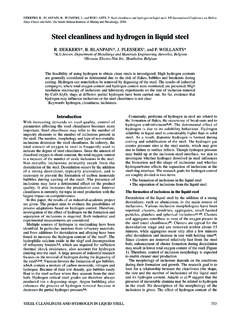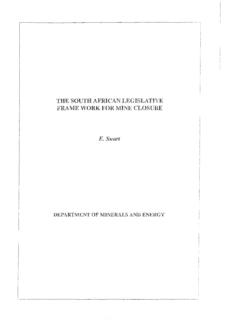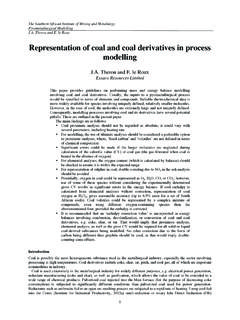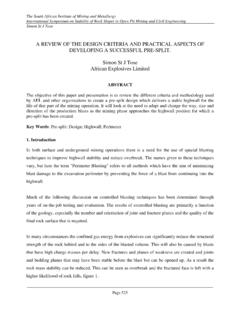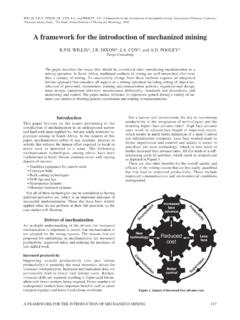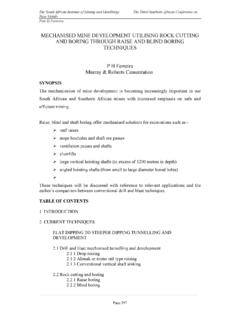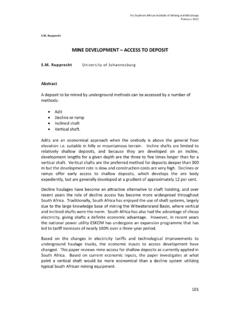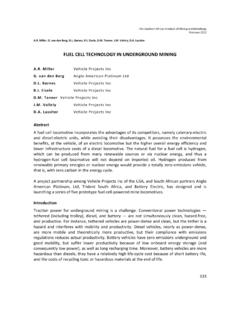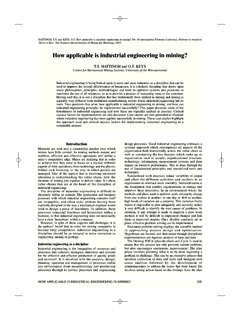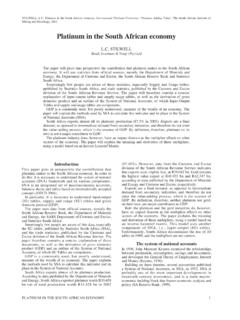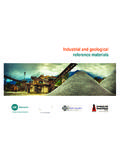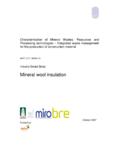Transcription of Technical considerations and viability of higher titania ...
1 BURGER, H., BESSINGER, D., and MOODLEY, S. Technical considerations and viability of higher titania slag feedstock for the chloride process. The 7th International Heavy Minerals Conference What next', The Southern African Institute of Mining and Metallurgy, 2009. Technical considerations and viability of higher titania slag feedstock for the chloride process H. BURGER, D. BESSINGER, and S. MOODLEY. Exxaro Resources Increasing pressure is being experienced by chloride slag producers to produce slag with more than 90% TiO2. An increase in TiO2 content will significantly decrease the waste generated during the chlorination process and also reduce operational costs.
2 To produce a high grade slag requires increased electrical energy as well as increased reductant in the smelting furnace. The yield of metal from smelting increases considerably, but less slag is produced. The change in certain operational costs, such as refractory wear is, however, difficult to predict. In the chlorinator the utilization of a high grade slag reduces the amount of waste generated and the disposal costs. Value-in-use calculations show that the production cost of high grade slag is more than the savings realized at the pigment plant, based on certain cost and plant assumptions.
3 Introduction will bring significant Technical challenges for both feedstock suppliers and pigment producers. There is an increasing demand from TiO 2 pigment producers who utilize the chlorination process, to obtain high TiO 2 (>90 % TiO 2 ) slag as feedstock. Increased The future of slag as a TiO2 feedstock environmental pressure to minimize waste from the In the chlorination feedstock market, chloride slag chlorination process is one of the main drivers for this. The competes with synthetic rutile, natural rutile and upgraded chloride pigment process produces between 2 to 5 tons of titania slag.
4 Feedstocks can be classified into two distinct waste per ton of pigment product (Fischer, 1997). A categories based on the resource origin. Chloride slag is secondary driver for utilization of high grade slag is to generally produced from ilmenite sources containing < 60%. lower chlorine and petroleum coke costs. TiO2. However, SR, high grade QIT slag and natural rutile The feed to a chlorinator is usually a blend of a number requires a mineral resource containing secondary ilmenite of titania feedstocks, which could include the following: (>60% TiO2). The pie graph in Figure 1 gives an indication of the relative amounts of high TiO2 feedstocks for 2008 to Synthetic rutile (SR).
5 The chloride process (TZMI, 2009). Natural rutile High grade mineral resources are being depleted, Upgraded titania slag (UGS). specifically the mineral resources containing large High grade QIT slag (with ilmenite from QMM, quantities of secondary ilmenite. The impact of this over the Madagascar, not produced yet). next few years can be seen in Table I, which gives the Chloride slag predicted change in feedstock supply between 2007 figures Ilmenite (used only by DuPont). and estimated figures for 2015 (TZMI, 2008). It is estimated that about thirteen kilograms less waste is The anticipated change in supply is mainly triggered by generated for every percentage point increase in TiO 2 historically low level of capital investment in new resource feedstock (Exxaro, 2008).
6 For example, a ton of 85% TiO2 development a direct result of the low profitability of the slag will generate sixty-five kilograms more waste when titanium feedstock industry. compared with a 90% TiO2 slag. Producing a higher (>90%) TiO2 feedstock presents a challenge to the chloride slag producer (to upgrade the feedstock and remain cost competitive), given the increases in energy costs and reductant availability and quality. The various Technical and commercial challenges facing the feedstock supplier are discussed in this article, mainly from a slag producer perspective.
7 Through the application of value-in-use models for smelting and chlorination, a large part of the value chain will be analysed to determine the challenges and opportunities in producing a high grade slag. For the purpose of this article when reference is made to high grade slag, it will mean a 90% TiO2 equivalent slag. The conference theme of What next' certainly applies to Figure 1. Supply of TiO2 feedstocks to the CP producers in 2008. a changing feedstock market in the next five years. This (TZMI, January 2009). Technical considerations AND viability OF higher titania SLAG FEEDSTOCK 187.
8 Table I were used or these calculations, thereby providing Summary of predicted feedstock supply changes to 2015 information only on the trends. These results are shown in (TZMI, 2008) Figure 2. Also shown in Figure 2 are actual slag compositions from QIT, RBM and Namakwa Sands, as well Chloride 2015 Supply % Change Comments as pilot test work at the then Iscor MW furnace. The feedstocks ( 000 t) from 2007 slag composition data points at the lower right of Figure 2. Chloride ilmenite 613 10% Limited new availability are for slags with a total equivalent TiO2 content of 80%, Leucoxene 56 -57% Declining production from compared to 92% at the upper left.
9 These calculations show Tiwest, Iluka and DuPont that the slag composition can be manipulated by changing Rutile 772 28% Supply from new projects both the energy and reductant inputs. Over most of the map of slag compositions, the reductant Upgraded slag 380 11% Could possibly be expanded and energy isopleths run parallel. This implies that only a Chloride slag 1601 46% RTIT expansion single energy input rate can be used with a specific Synthetic rutile 373 -53% Declining Iluka production reductant addition. If the energy input rate is changed by 50. Total 8% kWh/t ilmenite, the carbon addition must be increased by 10 kg/t ilmenite.
10 If this ratio is not maintained the system will depart from the steady state condition at the slag liquidus temperature. An increase in slag temperature could result in decreasing the size of the freeze lining protecting The challenge that pigment producers face is that they the sidewall refractories, while a lowering in slag will have to be more flexible to adapt their mix of temperature could result in solids being present in the slag feedstocks. The demand for higher TiO2 chloride slag will with a resultant increase in slag viscosity. also increase as the synthetic rutile supply decreases.
